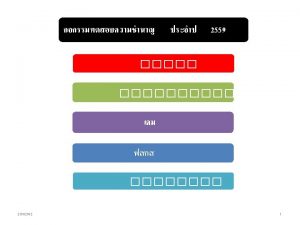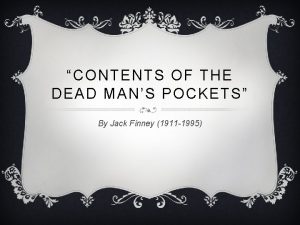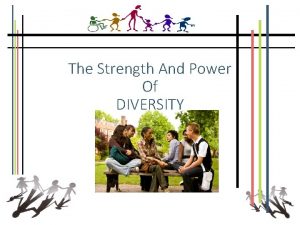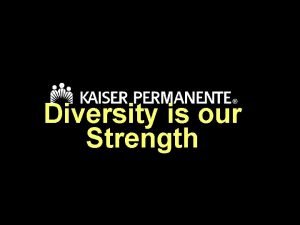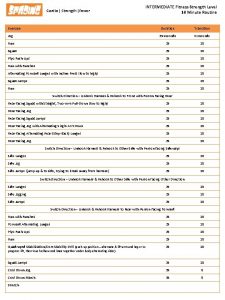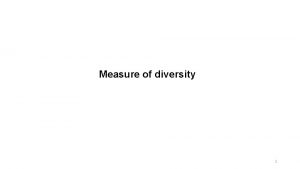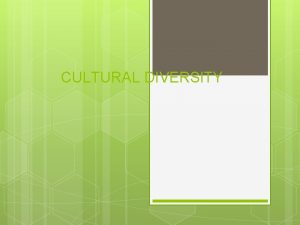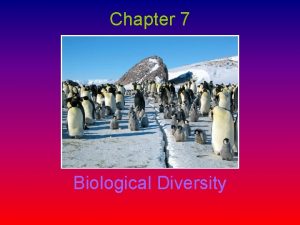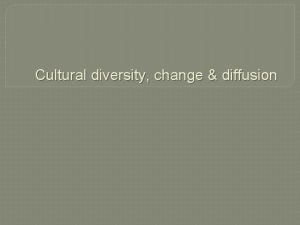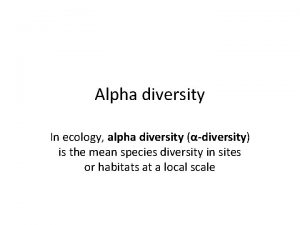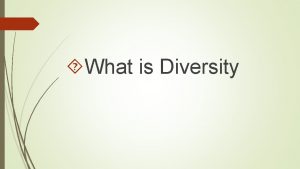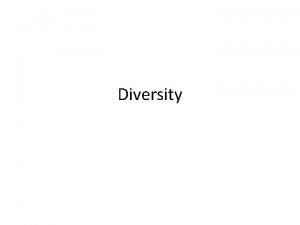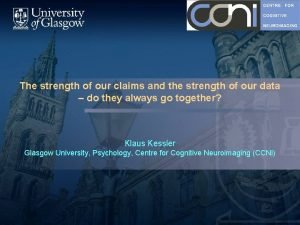The Strength And Power Of DIVERSITY Contents 1





















































- Slides: 53

The Strength And Power Of DIVERSITY

Contents 1. 2. 3. 4. 5. 6. 7. 8. 9. Objectives Self Assessment What is Diversity? Important Definitions What is Culture? What is Cultural Competence? Have you been Unfairly Judged? Cultural Jeopardy What is Linguistic Competence?

What you will learn … This Power. Point presents specific cultural competency strategies that can be used in delivering culturally competent services to diverse populations. The presentation highlights the importance of developing culturally appropriate behaviors that take into account the knowledge, attitudes, and beliefs of the residents of Anne Arundel County.

Objectives Participants will: • Perform a cultural sensitivity self-assessment • Identify correct definitions of key words • Demonstrate an understanding of cultural differences in behaviors, attitudes and beliefs • Understand that assumptions can lead to stereotypes and unfair judgments about individuals and groups. • Identify appropriate communication skills and strategies to meet the cultural and linguistic needs of children and families • By the completion of this presentation , participants will be able to discuss the strength and power of diversity.

Self Assessment This tool was developed to heighten your awareness of how you view families from culturally and linguistically diverse populations. There is no answer key; however, it will be important for you to review your responses. For self-assessment click here

Food for Thought • What did you learn about yourself? • What kinds of things might you change? • What will it take for you to make those changes? As you proceed through this presentation you will be provided with some tools to help you take the next steps.

What is Diversity? ü Different work styles ü Racial differences ü Ethnic differences ü Age span ü Social class ü Regional differences ü Sexual Minority ü Religion ü Political affiliation ü Skills ü Abilities/Disabilities

Demographics • The U. S. is becoming an increasingly diverse society • This diversity means that many different cultures operate in our communities and neighborhoods • The youth and families we work with represent an amazing array of diversity and cultural richness Decker, Decker & Brown, 2007

Linguistic Diversity 14% of the total U. S. population speak a language other than English at home. 54% of those speak Spanish. Child Trends, 2005

Why is Cultural Diversity an Important Issue? The U. S. is becoming a multicultural Society: • By 2040 no race will make up a majority • By 2050: – The U. S. African American population will increase from 13% to 14% – The Hispanic population will increase from 14% to 25%. – The Caucasian population will decrease from 74% to 50%. – The Asian population will increase from 3% to 8%. National Association of State Boards of Education, 2002

Growth in Anne Arundel Population 1990 -2008 1990 2008 % change Total 427, 239 512, 790 +20% Non-Hispanic White 361, 609 384, 706 +6% Hispanic 6, 815 23, 036 +238% African-American 49, 954 76, 748 +54% NEC 8, 861 28, 300 +219%

Why is Cultural Diversity an Important Issue? The U. S. is becoming a multicultural Society: • By 2040 no race will make up a majority • By 2050: – The U. S. African American population will increase from 13% to 14% – The Hispanic population will increase from 14% to 25%. – The Caucasian population will decrease from 74% to 50%. – The Asian population will increase from 3% to 8%. National Association of State Boards of Education, 2002

Why is Cultural Diversity an Important Issue? • Persons with physical and mental challenges comprise the largest minority in the U. S. with approximately 50 million individuals and almost 20% of the population • About 25 million Americans identify as gay, lesbian, bisexual or transgendered • According to the 2010 census, the number of Latinos in Anne Arundel County increased by 20, 000

Definitions That Assist In Establishing Common Ground Race Ethnicity One of four groups: White; Black; American Indian and Alaska Native; and Asian and Pacific Islander (US Census, 2000). Selected cultural and sometimes physical characteristics used to classify people into ethnic groups or categories. American ethnic groups include Native Americans, Hispanics, Indians, Latinos, Chinese, African Americans, European Americans and so on (O’Neil, 2004).

Definitions That Assist In Establishing Common Ground Racism The belief that race is the primary determinant of human traits and capacities and that racial differences produce an inherent superiority of a particular race. Sexism The belief in the inherent superiority of one sex (gender) over the other and thereby the right to dominance. Homophobia Fear or hatred of, aversion to or prejudice and/or discrimination against people who are homosexual

What is Culture? The integrated pattern of human behavior that includes thoughts, communication styles, actions, customs, beliefs, values and institutions to ensure that the needs of the children, youth and families are met within the context of their culturally informed world view. CULTURE: Shapes our Understanding and Perceptions Forms our Identity Organizes our physical and social interaction

Why Culture Matters It affects… • • • Parenting and child rearing Communication Body language Perception of time Help-seeking behaviors; help-giving behaviors; stigma Attitudes and beliefs about the law, services, social support, kinship support, and what constitutes successful services Use of services and social supports Understanding of government systems How we see the world Lazear, K. , 2003.

Understanding Cultural Differences • Family is defined differently by different cultures • The concept of an exact time is not used or reinforced in some cultures. • Some cultural groups stress the veneration of ancestors • Eye contact varies by culture. • Physical distance during social interactions varies by culture. • Culture greatly influences attitudes about physical contact. • Different cultures regulate the display of emotion differently • Some cultures may use different standards for loudness, speed of delivery, silence, attentiveness and time to respond to another's point

Reflect on Your Own Culture! The best way to understand culture is to explore your own! Think about these questions: • What holidays and major events do you celebrate? Why? How would it feel if you were told you would no longer be allowed to celebrate those? • How did growing up and/or where you grew up shape your view of the world? (Think of the differences between your generation and your parents’ generation) • How does your gender shape your aspirations in life? • Who do you admire and why? What characteristics do they have? CLICK HERE FOR EXAMPLES OF CULTURAL DIFFERENCES

The Strengths of Cultural Diversity • Offers an environment of inclusion, that is supportive and collaborative and increases productivity and loyalty • Promotes equity and equal opportunity. • Encourages interaction among diverse people to enrich the educational experience, promote personal growth and enhance the community. • Fosters mutual respect, value differences and promotes cross cultural understanding. • Prepares community members to live and work in a competitive global economy.

What is Cultural Competence? Cultural competence is a set of behaviors and attitudes that professionals use to: • Understand their own values and culture • Value diversity and cultural difference in their clients • Adapt to the culture of the family or community they are serving • Work effectively in cross-cultural situations CLICK HERE FOR TEN TIPS ON CULTURAL SENSITIVITY Adapted from Cross , Isaac & Benjamin, 1991.

Cultural Competence Skills Include: • Being aware of your own culture and values • Respecting differences. • Being aware of and working at controlling your own biases and how they affect interactions with others. • Understanding institutional barriers that prevent some families from accessing resources. • Building strong cross cultural team relationships. • Advocating for individuals who are different from yourself. • Using effective communication skills across differences. • Mediating cross-cultural conflicts. • Being flexible.

Don’t Assume! • The assumptions we make based on a person’s appearance often lead to misjudgments • We may not “hear” what youth and families have to say because we have already decided that they have nothing to contribute based on our own biases relating to the person’s appearance or situation • Our preconceptions may adversely affect our ability to communicate effectively with those who are different from us

Labeling • We often use labels or categories to describe others. • These labels can be based on such characteristics as clothing, looks, the way a person talks, or the groups to which he or she belongs. • Grouping is a natural human inclination; however, people often make assumptions about groups of people they don’t even know.

Stereotyping Preconceptions and Stereotypes function as negative lenses through which people perceive others who look, think, or behave differently. (Hogan-Garcia, 2003, p. 52) • Stereotyping occurs when we use misinformation to judge everyone who belongs to a specific group. For example, if we are walking through a park late at night and encounter three senior citizens wearing fur coats and walking with canes, we may not feel as threatened as if we were met by three high school-aged boys wearing leather jackets. Why is this so? Because we have made a generalization in each case. • Stereotypes also evolve out of fear of persons from minority groups Grobman, G. 1990

To Avoid Stereotyping • Acknowledge the existence of your own preconceptions. • Be critical of yourself. Don't take for granted any opinion that pops into your head. • Work to understand how your preconceptions impact the way you view others. • Know your labels and to whom you relegate them. • Slow down and get more information.

Have you Been Unfairly Judged? Think about a situation when someone made a biased judgment about you or acted unfairly toward you because of your age, skin color, clothes you were wearing, your weight, gender, the way you speak, where you live, how much money you have, what you do for a living/work, or some other reason. How did that make you feel?

Cultural Competence Can Help Address Disparity & Disproportionalities Culturally diverse individuals and communities: • Are over-represented in the criminal justice system • Have less access to, and availability of, health and mental health services • Are less likely to receive needed services • Are under-represented in human services research • Are over-represented in special education classes • Are over-represented in restrictive levels of care (foster care, residential, juvenile detention) Lazear, K. (2005)

Cultural Competence Continuum Cultural competence at the organizational and individual levels is an ongoing developmental process. The following chart is designed to highlight selected characteristics that organizations may demonstrate along the stages of the cultural competence continuum. Cultural Competence Cultural Pre-Competence Cultural Blindness Cultural Incapacity Cultural Destructiveness LEARN MORE BY CLICKING HERE Adapted from Cultural and Linguistics Competence - NABHA Training of Trainers (2007 Draft) Cultural Proficiency

‘Cultural Jeopardy’! How to play: A definition will be presented and you must determine the appropriate word from the list Adapted from the Texas Alcohol and Drug Abuse Cultural Sensitivity Training, 2002

Cultural Jeopardy! Stereotyping Cultural competence Ethnicity Race Culture Diversity Selected cultural and sometimes physical characteristics used to classify people into ethnic groups or categories. American ethnic groups include Native Americans, Hispanics, Indians, Latinos, Chinese, African Americans, European Americans and so on. Ethnicity

Cultural Jeopardy! Stereotyping Cultural competence Ethnicity Race Culture Occurs when we use misinformation to judge everyone who belongs to a specific group Diversity Homophobia Sexism Racism Stereotyping

Cultural Jeopardy! Stereotyping Cultural competence Ethnicity Race One of four groups: White; Black; American Indian and Alaska Native; and Asian and Pacific Islander. Culture Diversity Homophobia Sexism Racism RACE

Cultural Jeopardy! Stereotyping Cultural competence Ethnicity Race Culture Diversity The belief in the inherent superiority of one sex (gender) over the other and thereby the right to dominance. Homophobia Sexism Racism sexism

Cultural Jeopardy! Stereotyping Cultural competence Ethnicity Race Culture Fear or hatred of, aversion to or prejudice and/or discrimination against people who are homosexual Diversity Homophobia Sexism Racism HOMOPHOBIA

Cultural Jeopardy! Stereotyping Cultural competence Ethnicity Race Culture Diversity Homophobia The belief that race is the primary determinant of human traits and capacities and that racial differences produce an inherent superiority of a particular race. Sexism Racism racism

Cultural Jeopardy! Stereotyping Cultural competence Ethnicity Race Culture Diversity Homophobia Sexism Racism A set of beliefs, behaviors, and interactional patterns that identify a person with a larger social or ethnic group Culture

Cultural Jeopardy! Stereotyping Cultural competence Ethnicity Race Culture Diversity Homophobia Sexism Racism The ability to interact effectively with people of different cultures. Comprises an awareness of one's own cultural worldview, attitude towards cultural differences, knowledge of different cultural practices and crosscultural skills. Cultural competence

Disproportionate Minority Contact in the Juvenile Justice System

What is Disproportionate Minority Contact? • Youth of color are disproportionately represented, nationally, at every decision making point in the juvenile justice system and this disproportionate representation increases as they move deeper into the system. • According to the Anne Arundel County 2005 -2008 Relative Rate Index (RRI), African American males are disproportionately represented in the Anne Arundel County's juvenile justice system when compared to the rates of contact for Caucasian males

RRI Decision Points

DJS Reports on DMC. 2007 2010

How You Can Help Address DMC in Anne Arundel County Join the Anne Arundel County Disproportionate Minority Contact Committee! • Membership includes law enforcement, courts, mental health, the Partnership, conflict resolution bureau, County Executive’s office and many more • Meets fourth Thursday of every month, 12: 30 -1: 30 in the law library of the County Courthouse, Annapolis.

Improving Communication

Communication And Linguistic Competence You must be a Good Listener! • Smile and look interested • Be patient • Listen carefully and don’t interrupt

Ways to Facilitate Communication Across Cultural Boundaries 1. Recognize differences 2. Build Your Self-Awareness 3. Describe and Identify, then Interpret 4. Don’t assume your interpretation is correct 5. Verbalize your own non-verbal signs 6. Share your experience honestly 7. Acknowledge any discomfort, hesitation, or concern 8. Practice politically correct communication 9. Give your time and attention when communicating 10. Don’t evaluate or judge 11. Be cautious about humor (new English speakers find humor difficult to understand)

Communication with Culturally Diverse Residents When you work with culturally diverse populations: • Learn culturally specific information • Know some words and phrases in the family’s language • Use trained interpreters who can interpret language as well as cultural cues • Limit the number of forms and other paperwork

Do’s of communicating with Limited-English Speakers • • Make your statements as specific as possible Let the person see your lips as you speak Be aware of your assumptions Don’t rush – be patient Speak a little more slowly but not more loudly Be careful with your pronunciation Stick to the main points Avoid jargon Jill San Jule, Mental Health Transformation Project

Do’s of Communicating with Limited-English Speakers • Emphasize key words • Use simple sentence structure • Keep pencil and paper handy and write key information down • Use body language to illustrate what your words say • Ask the person to write down any words you have difficulty understanding

Core Elements of a Culturally and Linguistically Competent System • Commitment from top leadership and resources • Strategic plan with meaningful involvement of key diverse persons • Needs assessment/data collection (e. g. organizational self -assessment, evaluation/research activities that provide on -going feedback) • Mission statements, definitions, policies, and procedures reflecting the values and principles • Recruitment and retention of diverse staff, including training and skill development • Certification, licensure, and contract standards • Targeted service delivery strategies. Adapted from Isaacs, M. , Benjamin, M. , et al. (1989 -1998). Towards a culturally competent system of care (Vols 1 -3). Washington, DC: Georgetown University Child Development Center, National Technical Assistance Center for Children’s Mental Health.

References Decker L. E. , Decker, V. A. , and Brown, P. M. (2007). Diverse Partnerships for Student Success: Strategies and Tools to Help School Leaders. Lanham, MD: Rowman and Little. Field Education Carne, J. (1996). Us and Them: A History of Intolerance in America. Oxford University P Child Trends (2005). Race and Ethnicity Trends. http: //www. childtrendsdatabank. org/ Cross, T. , Bazron, B, Dennis, K. W. , & Isaacs, M. R. (1989). Towards a Culturally System of Care, Volume I. Washington, DC Fuyo Gaskins, P. (1999) What Are You? Voices of Mixed-Race Young People. Henry Holt and Company Garland, A. & Bessinger, A. (1997). The color of mental health. Children and Youth Goode & Jones (modified 2004). National Center for Cultural Competence, Georgetown University Center for Child & Human Development. http: //www 11. georgetown. edu/research/gucchd/NCCC/foundations/frameworks. html Grobman, G. (1990). Stereotypes and Prejudices. A Guide for Teachers. Hoopes, D. & Ventura, P. (1979. ). Intercultural source book. Cross cultural training methodologies. Yarmouth: Maine. Intercultural press Lazear, K. (2005). Primer hands on. Human Service Collaborative: Washington D. C. Adapted from Mental Health Culture, Race and Ethnicity – Executive Summary – A Supplement to the Mental Health Report: A Report of the Surgeon General (2001).

References National Association of State Board's of Education Study Group (2002). A more perfect union: Building an educational system that embraces all children. Alexandria, VA: National State Board of Education Nieto, S. (2002). Language, culture and teaching: Critical perspectives for a new century. Mahwah, NJ: Lawrence Erlbaum Associates. SAMHSA, (1998). Building a System of Care http: //mentalhealth. samhsa. gov/publications/allpubs/cbe 198/chp 1. asp San Jule, J. (2008) Mental Health Transformation Project http: //mhtransformation. wa. gov/MHTG/contact. shtml Takeuchi, K. Bui, K. & Kim, L. (1993) The referral of minority adolescents to community mental health centers. Journal of Health and Social Behavior, 24 (11) Tatum B. D. (1997). Why are all the black kids sitting together in the cafeteria? New York: Basic Books Texas Alcohol and Drug Abuse Cultural Sensitivity Training, (2002). http: //www. dshs. state. tx. us/mhsatraining/courses. shtm#Cul. ST Walker s (2002) Culturally Competent Protection of Children’s Mental Health. Child Abuse Review 11, 6 380 -393

References Nieto, S. (2002). Language, culture and teaching: Critical perspectives for a new century. Mahwah, NJ: Lawrence Erlbaum Associates. SAMHSA, (1998). Building a System of Care http: //mentalhealth. samhsa. gov/publications/allpubs/cbe 198/chp 1. asp San Jule, J. (2008) Mental Health Transformation Project http: //mhtransformation. wa. gov/MHTG/contact. shtml Takeuchi, K. Bui, K. & Kim, L. (1993) The referral of minority adolescents to community mental health centers. Journal of Health and Social Behavior, 24 (11) Tatum B. D. (1997). Why are all the black kids sitting together in the cafeteria? New York: Basic Books Texas Alcohol and Drug Abuse Cultural Sensitivity Training, (2002). http: //www. dshs. state. tx. us/mhsatraining/courses. shtm#Cul ST
 Tensile strength and yield strength
Tensile strength and yield strength Half strength darrow's uses
Half strength darrow's uses Genetic diversity and biodiversity
Genetic diversity and biodiversity Genetic diversity vs species diversity
Genetic diversity vs species diversity How to calculate percentage strength w/v
How to calculate percentage strength w/v Ratio strength
Ratio strength Draw the power triangle
Draw the power triangle Diversity factor of a power system
Diversity factor of a power system Hình ảnh bộ gõ cơ thể búng tay
Hình ảnh bộ gõ cơ thể búng tay Ng-html
Ng-html Bổ thể
Bổ thể Tỉ lệ cơ thể trẻ em
Tỉ lệ cơ thể trẻ em Gấu đi như thế nào
Gấu đi như thế nào Tư thế worm breton
Tư thế worm breton Hát lên người ơi alleluia
Hát lên người ơi alleluia Các môn thể thao bắt đầu bằng tiếng nhảy
Các môn thể thao bắt đầu bằng tiếng nhảy Thế nào là hệ số cao nhất
Thế nào là hệ số cao nhất Các châu lục và đại dương trên thế giới
Các châu lục và đại dương trên thế giới Công thức tiính động năng
Công thức tiính động năng Trời xanh đây là của chúng ta thể thơ
Trời xanh đây là của chúng ta thể thơ Cách giải mật thư tọa độ
Cách giải mật thư tọa độ 101012 bằng
101012 bằng độ dài liên kết
độ dài liên kết Các châu lục và đại dương trên thế giới
Các châu lục và đại dương trên thế giới Thể thơ truyền thống
Thể thơ truyền thống Quá trình desamine hóa có thể tạo ra
Quá trình desamine hóa có thể tạo ra Một số thể thơ truyền thống
Một số thể thơ truyền thống Cái miệng xinh xinh thế chỉ nói điều hay thôi
Cái miệng xinh xinh thế chỉ nói điều hay thôi Vẽ hình chiếu vuông góc của vật thể sau
Vẽ hình chiếu vuông góc của vật thể sau Thế nào là sự mỏi cơ
Thế nào là sự mỏi cơ đặc điểm cơ thể của người tối cổ
đặc điểm cơ thể của người tối cổ Thế nào là giọng cùng tên
Thế nào là giọng cùng tên Vẽ hình chiếu đứng bằng cạnh của vật thể
Vẽ hình chiếu đứng bằng cạnh của vật thể Fecboak
Fecboak Thẻ vin
Thẻ vin đại từ thay thế
đại từ thay thế điện thế nghỉ
điện thế nghỉ Tư thế ngồi viết
Tư thế ngồi viết Diễn thế sinh thái là
Diễn thế sinh thái là Dạng đột biến một nhiễm là
Dạng đột biến một nhiễm là Số nguyên tố là số gì
Số nguyên tố là số gì Tư thế ngồi viết
Tư thế ngồi viết Lời thề hippocrates
Lời thề hippocrates Thiếu nhi thế giới liên hoan
Thiếu nhi thế giới liên hoan ưu thế lai là gì
ưu thế lai là gì Hươu thường đẻ mỗi lứa mấy con
Hươu thường đẻ mỗi lứa mấy con Khi nào hổ mẹ dạy hổ con săn mồi
Khi nào hổ mẹ dạy hổ con săn mồi Sơ đồ cơ thể người
Sơ đồ cơ thể người Từ ngữ thể hiện lòng nhân hậu
Từ ngữ thể hiện lòng nhân hậu Thế nào là mạng điện lắp đặt kiểu nổi
Thế nào là mạng điện lắp đặt kiểu nổi Solar power satellites and microwave power transmission
Solar power satellites and microwave power transmission Actual power and potential power
Actual power and potential power Dispersive power of a grating is defined as
Dispersive power of a grating is defined as Contents of the dead man's pocket
Contents of the dead man's pocket
